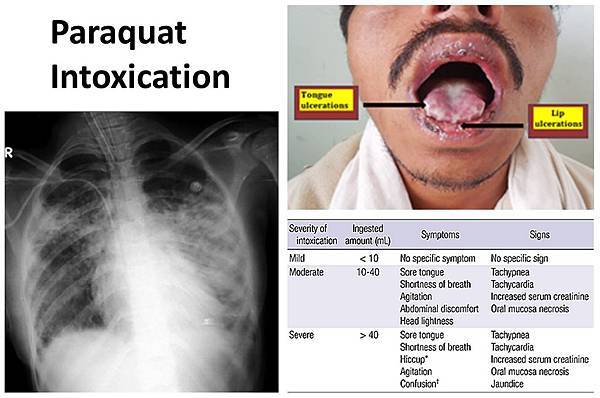- Ulcerations of mouth and lips
- Bilateral lung infiltrates / Desaturation 肺
- Acute kidney injury / Renal failure 腎
- Jaundice / Liver failure 肝

巴拉刈 不是 Parathion (巴拉松) : 除草劑, 有機磷農藥
巴拉刈 : 廣泛作為去除雜草劑
1,1-dimethyl-4,4-bipyridinium dichloride
速草淨 (正豐), 綜免刈 (功力), 全草滅 (日農), 草蕪松 (興農), 巴拉刈
克蕪蹤 (ICI GRAMOXONE & WEEDOL), 可樂松及42%巴達刈 (保達克混合水劑)
局部會有口腔燒灼感, 噁心嘔吐, 腹痛腹瀉 (偶有血便)
數小時後, 口腔, 喉部及腸胃道會產生發炎反應及潰瘍
2~3天之後
可能會有肝臟或是腎臟衰竭
視所喝的量而定
巴拉刈在12-24小時內由腎臟排除的過程中, 巴拉刈會被高度濃縮
在24小時內造成急性腎小管壞死
中毒後5~10天會出現對肺臟的傷害
開始會有呼吸困難, 肺水腫, 肺纖維化
巴拉刈會在肺臟產生毒性的活性氧自由基, 對肺部造成嚴重傷害
大部分病人無法恢復, 最後因呼吸衰竭而死亡

中毒的患者可以由 :
血漿中巴拉刈濃度,
尿液和血漿的二亞硫酸鈉(Sodium dithionite)
檢驗及臨床症狀的嚴重度來看其預後好壞
服用後緊急處理
- 吸附劑 : Fuller's earth (陶土), Bentonite (皂土), 活性碳 (activated charcoal)
- 緩瀉劑
- hemoperfusion + charcoal
- 抗氧化劑
因為Paraquat在體內會產生大量自由基, 所有有許多抗自由基的藥物, 全部被用來治療
包括Vit. C, Vit. E, acetylcysteine (NAC), SOD..
- 免疫 :
Pulse therapy :
High-dose cyclophosphamide (~15 mg/kg/day) + methylprednisolone 1 gm/day
Normal-dose therapy:
cyclophosphamide (~1.5-2.0 mg/kg/day) + dexamethasone 5~10 mg/day

除非出現嚴重的缺氧現象, 否則不建議使用氧氣治療
因為會惡化氧化壓力, 且動物實驗也証實會增加死亡率
並非每個中毒患者都建議洗胃
因為被吸附劑吸附和自我嘔吐後可再被排除的巴拉刈
其實占很少部份, 且可能造成吸入性肺炎
巴拉刈經口腔及胃腸道吸收快速
如果病人能在1-2小時內治療的胃腸道去污效果最好
對巴拉刈的清除率而言
血液灌洗比血液透析來得好
若在中毒後6-12小時內使用血液灌洗治療, 有可能會降低死亡率
免疫抑制療法最常用的製劑
Cyclophosphamide, Methylprednisolone, Dexamethasone
巴拉刈是劇毒, 只要喝下超過15cc就屬嚴重中毒
在歐美死亡率高達8, 9成以上
但長庚十年經驗, 接受此標準治療, 死亡率已降至54%
相反的, 存活率一舉提高到46%, 可以救回一半
Initial Hospital Management
1. Ensure Airway, Breathing and Circulation are intact
2. Control vomiting with
- 5HT3 antagonists
e.g. Ondansetron 8mg (5mg/m2 in children) by slow i.v. injection or i.v. infusion over 15 minutes
- Phenothiazine anti-emetics e.g. prochlorperazine
Dopamine antagonists such as metoclopramide should be avoided
as they may impair therapy for renal support with dopamine
3. Decontamination :
- Activated charcoal
100g for adults or 2 g/kg body weight in children [50g Stat and 25g 4 hourly]
- Fuller' s Earth
15% solution; 1 litre for adults or 15ml/kg body weight in children [300ml Stat than 20ml every hour till diarrhoea]
* The use of gastric lavage without administration of an adsorbent
has not shown any clinical benefit.
- A purgative should also be used e.g. mannitol or magnesium sulphate
- Rehydrate the patient to optimise renal clearance of paraquat,
paying attention to the possibility of fluid overload and electrolyte imbalance.
* Forced diuresis is not recommended
4. Do not give supplemental oxygen unless serious hypoxia is present
Subsequent Management
i.v. fluids – the kidney is the major route of excretion of paraquat
and renal function must therefore be closely monitored and optimum function maintained.
Analgesics – aggressive analgesia (e.g. opiates) may be required
since patients can have severe pain from oral, oesophageal or abdominal corrosive injury.
Mouth care for ulceration and inflammation.
patients should be kept nil by mouth if there is a suspicion of oropharyngeal or oesophageal injury
Immunosuppresion widely practised as a treatment of paraquat self-poisoning
The theory is that as paraquat leads to an acute inflammatory response,
interference with this may inhibit the processes that follow that then lead to lung fibrosis and death
might have a role in moderate to severe poisoning
methyprednisolone 15mg/kg +/- Cyclophosphamide 15mg/kg
followed by a high dose Dexamethasone [Sarawak Handbook 3rd edition]
other treatment used are
1 g of cyclophosphamide daily for 2 days and 1 g of methylprednisolone daily for 3 days
current practice 15mg/kg in 250 NS for 2 days


http://www.tsim.org.tw/journal/jour24-1/06.PDF
巴拉刈中毒的治療新進展 - Taiwan Society of Internal Medicine
http://jerryljw.blogspot.tw/2007/04/paraquat-intoxication.html


 留言列表
留言列表


